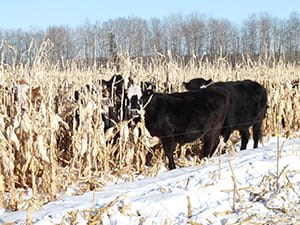KINDERSLEY — Thanks to the adoption of soil conservation practices such as minimal tillage and direct seeding, shelterbelts on the Saskatchewan landscape are not nearly as common as they once were but they can still provide environmental and economic advantages to producer operations.
Shelterbelts provide many environmental benefits, including improving water infiltration, reducing soil erosion and providing wildlife habitat. Tree rows can provide refuge for game animals, birds of prey, tree-nesting birds, pollinators and crop-pest predators. Providing habitat for pollinators can aid pollination and seed set of insect-pollinated crops such canola. Similarly, tree rows provide refuge for crop-pest predators and birds of prey, which can also benefit crop production, as they help to control pests. Shelterbelts can also restrict weed seed movement and buffer pesticide drift. Some tree and shrub species produce edible fruit and nuts, while other species provide beneficial functions such as nitrogen fixation.
Additionally, to protect soil from erosion, shelterbelts can aid in crop production. By reducing wind speeds, they help minimize evaporation, leaving more moisture for crop growth. In the winter, these protective barriers capture snow, creating banks that gradually release moisture as spring arrives. The root systems of the trees and shrubs within shelterbelts can help with moisture management. During dry periods, these deep roots draw up the water table, making it available for crop uptake. Conversely, in wet conditions, the same root systems can make use of excessive moisture, lowering the water table.
Shelterbelts also provide benefits to livestock production by reducing wind speeds and by providing shade. By acting as a windbreak, they can reduce the windchill experienced by animals throughout Saskatchewan winters which improves animal health and welfare, reducing feed requirements and improving weight gain. When used in livestock wintering sites, shelterbelts can mitigate nutrient runoff by improving moisture infiltration, slowing runoff, and acting as a buffer to absorb excess nutrients and preventing pathogens from entering waterways. As such, shelterbelts can be a useful tool to incorporate into an extensive wintering site.
Under the , the provides funding to assist livestock producers to improve their management of extensive livestock wintering sites, including the use of shelterbelts for livestock shelter and nutrient runoff mitigation. To learn more about the program, visit our website or call the Agriculture Knowledge Centre at 1-866-457-2377.




